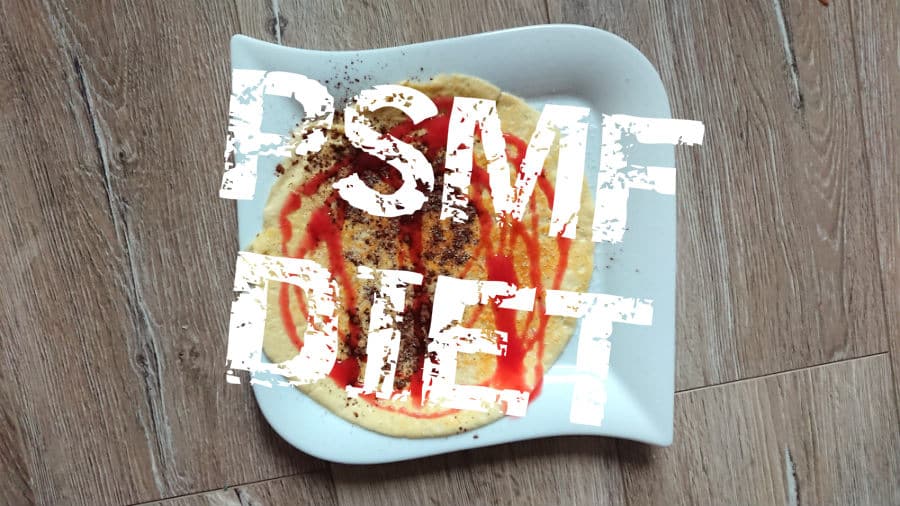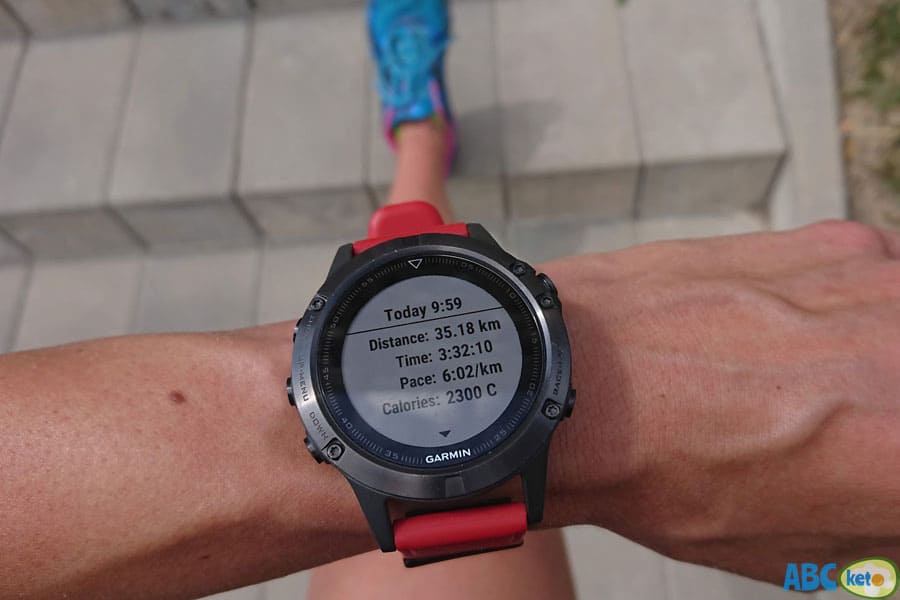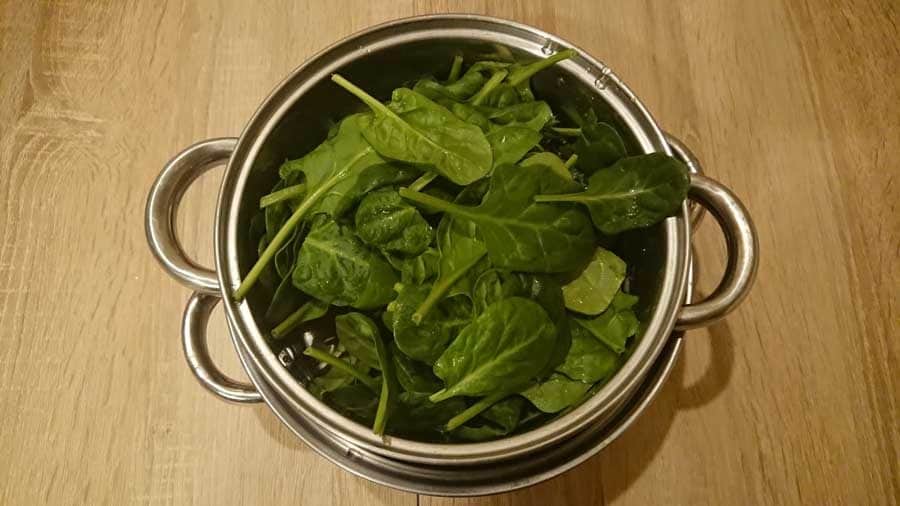
Keto Tuna Salad (With Eggs, Mayo & Leafy Greens)
June 18, 2018
PSMF Diet Plan: My Detailed PSMF Diet Meal Plan For 3 Months
July 7, 2018Protein Sparing Modified Fast. PSMF Diet Becomes My New 90-Day Challenge

A few words about the PSMF diet and why I decided to switch to it for the next 90 days (13 weeks).
If you’ve been following ABC Keto for some time, you know that I like trying out new things and keep improving. Since my trip to Seychelles, I’ve got off track a little bit (and gained a bit of weight). Even though my diet wasn’t perfect during this “chillout” time, I read a couple of books about keto and its different variations. I was looking to modify a standard keto diet so that I can do intensive running and crossfit workouts almost daily without wearing myself down and still losing weight.
In one of the books (Eat Rich, Live Long by I. Cummins), I learned about a more “advanced” version of a keto diet aimed at rapid fat (not weight) loss. This keto diet variation is called PSMF which stands for protein sparing modified fast. I quickly loved the idea and after reading another book specifically about it (The Complete Rapid Weight/Fat Loss Solution by Lyle McDonald), I decided to give this program a try.
In this post you will learn what a protein sparing modified fast is, how it works, and what I want to achieve with this tool. I will also keep updating this post so that you can see my current PSMF diet results and weekly progress.
UPDATE: I decided to discontinue PSMF after one moth. You can learn why later in this post and in the conclusion section.
Why My PSMF Challenge May Interest You
This experiment may be quite interesting for many people at least for a couple of reasons:
- I’ve tried probably every diet in the world and graduated from a complete diet ignoramus to a highly “food and nutrition conscious” person.
- My system is used to tons of exercise and isn’t very “responsive” to it. I can run 10 kilometers a day and gain weight quite easily if I fall off the wagon with my diet.
- I have a lot of experience with intermittent fasting, prolonged fasting, OMAD, TMAD and other extreme weight loss solutions. I can also say that my system is used to fasting and doesn’t respond to it so well any more.
- I also have a history of eating junk food and tons of sweets on a daily basis.
- I don’t have a ton of weight to lose (I’m within the normal range) but I’m not very thin either. This is probably the point where fat loss becomes the hardest.
- I’ve never achieved my target running weight or even got very close to it (which is the BMI of 18-19). I’ve been looking for the right type of diet or eating program for the past ten years. Keto combined with intermittent fasting let me get quite close to my goal but there are still some modifications I need to make. I believe PSMF is the missing puzzle piece to my keto diet.
All of the above reasons make it much more difficult for me to lose weight and burn fat than it is for a regular person who is just starting out. That’s why I’m extremely curious how PSMF will work for me (this is probably the only “diet” I haven’t tried yet). If it works for me, the chances are it will work for the majority of “normal” folks.
What PSMF (Protein Sparing Modified Fast) Is & How It Works
As the name suggests, PSMF is a form of fasting which allows you to lose a lot of fat while retaining all or most of your muscle mass. This is a low-calorie diet which, at the same time, is a type of a ketogenic diet (because it induces ketosis).
The protein sparing modified fast diet was originally used to treat morbidly obese patients with BMI above 30. However, recently more and more physically-active or slightly overweight people have become interested in this program because of its high effectiveness and very quick results (usually two times faster than on other weigh loss programs)
Though the original version was full of mistakes and often led to malnutrition, the new, updated and common sense version of the protocol makes sure you are provided with all the necessary vitamins, minerals and electrolytes so that you can stay healthy or even improve your health during the program (in addition to losing lots of weight).
Except for weight loss, the protein sparing modified fast can give you the benefits similar to a keto diet, that is, lower blood pressure, lower blood sugar levels, less insulin resistance, healthy cholesterol levels and more.
The biggest possible disadvantage of this diet (and the biggest difference from a keto diet) is that PSMF drastically reduces calories. In most cases people eat around 800 kcal a day, which is a huge deficit pretty much for everyone. Very low-calorie diets are often associated with conditions such as low energy, fatigue, dizziness, headaches, menstrual cycle disruptions, constipation, hair loss, muscle cramps or constipation.
That’s why, to avoid negative consequences, the PSMF diet incorporates regular refeeds, free meals, diet breaks, supplementation and focuses on healthy whole foods (more about it below).
You can learn more about this diet on the PSMF diet website. The guidelines are similar to what you find in the Complete Rapid Weight/Fat Loss Solution book by Lyle McDonald. I suggest studying both of these resources as well as doing your own research.
The Main Rules Behind PSMF Diet
The diet is very simple at its core. You need to calculate your protein needs, reduce fat and carbs and stick to a set of rules. The main rules include:
- LOW CARB: You are allowed to eat 20-50 g of carbs a day to induce ketosis.
- LOW FAT: You can only eat 20-30 g of fat a day so that your body has to use your own body fat for energy.
- HIGH PROTEIN: 70-180 g of protein a day depending on your weight, BMI and other factors. Such a big amount of protein is necessary to keep you full and spare your muscles.
- LOW CALORIE: 800-1000 kcal a day depending on your activity level, weight BMI and other factors.
Since ketosis is the result of the restriction of carbohydrates (not consumption of fat), you enter ketosis pretty quickly on this eating plan. And that’s the whole point. Once you are in ketosis and eat trace amounts of fat (30 g of less), you will be using mainly your own body fat for energy. This leads to rapid weight loss because your body will have no other choice than to switch to its own fuel reserves. How cool is that? 🙂
Foods To Eat On A PSMF
The foods to eat on a PSMF diet pretty much comply with the keto diet foods except for foods rich in fat. This means you eat only lean sources of protein (like chicken, seafood, protein powders, cottage cheese, lean fish or egg whites) and avoid all the added fat (like oils, butter or fatty types of meat and fish).
Just like on a standard keto diet, you don’t need to restrict keto-friendly vegetables (especially leafy greens or basically any vegetables growing above the ground). The same is true for drinks with no calories like tea, coffee or water. Just like on a keto diet, occasional keto-friendly fruit is OK, so I will be eating one a day.
Macros On A Protein Sparing Modified Fast Diet
You calculate your own macros depending on your activity level, gender, body weight and current body fat. On the PSMF diet website there is a PSMF calculator that will let you calculate your macros for the duration of PSMF and your maintenance calories.
Since I am pretty active and have slightly more than 24% of BF, my PSMF macros are about 1000 kcal (20 g of fat, 20 g of carbs and 180 g of protein). The maintenance level for me is around 2500 kcal a day (90 g of fat, 90 g of protein and 300 g of carbs). Of course, my maintenance macros will look different once I switch to a keto diet. Here is what the calculator showed for me:

This is the PSMF diet calculator I used to calculate what body type I am.
And here are my macros for the duration of the diet:

These are my daily macros on a PSMF diet.
Since I’m very active and run 6-7 times a week (at least one hour per one training session and do 1-2 crossfit workouts a week), I modified my macros a little bit so that they are: 30 g of fat, 30 g of carbs and 150 g of protein. I will see how I feel after a week or more and maybe I will change them into what the calculator originally suggested.
My maintenance calories are pretty much compliant with what most online calculators show. Of course, I will not switch to a high-carb diet when I am done with PSMF. However, this is a good base for my refeed days, I believe.

These are my maintenance calories according to the PSMF calculator.
These are the macros for my 2-3 consecutive refeed days I am planning to have every two or three weeks.
Meal Timing & Duration Of PSMF
How long you need to follow the protein sparing modified fast diet depends on your goals and where you start. Morbidly obese people follow this protocol even for 6-8 months. For thinner people it’s usually enough to stick to PSMF just for a couple of weeks before they achieve their target weight.
The most important rule is to take breaks in the diet to avoid slow-down of metabolic rate and other negative effects. The forms of breaks a PSMF diet allows for are:
- Free meals which is simply eating one meal (usually in a week) without counting macros or calories. You simply go to a restaurant and order whatever you feel like eating. This, however, doesn’t mean bingeing or stuffing yourself with as much as you can within that one meal.
- Refeed days which are 2-3 consecutive days when you increase carbs and eat at your maintenance level or slightly above. In my case it’s 2414 kcal.
- Full diet breaks which last from 1 to 2 weeks when you simply eat at your maintenance level and increase all the macro-nutrients. This also doesn’t mean a week-long food orgy. You simply increase calories and macro-nutrients in relation to what you’ve been eating on PSMF.
And this is how often I should take breaks, refeed days and free meals according to the PSMF diet calculator.
I also did slight modifications here and I’m planning on:
- Having one free keto meal a week (over the weekend) if I really feel low in energy or faint.
- Having 2-3 refeed days every 11-20 days. I planned refeed days to be before or around my races so that I have enough energy to compete and don’t entirely wear myself down.
- Doing this until the end of September. After this date I will take a 1 or 2 week’s diet break and decide if I switch to maintenance or do another cycle of PSMF. If I switch to maintenance, I will, of course, switch to a regular keto diet.
Of course, what I set up for myself is not unchangeable. This is the initial plan that may be subject to change. It all depends on how I will feel down the road and if my sports performance is affected. I will keep you updated in this post.
My Goals With PSMF
To be honest, there are three major goals I want to achieve with the help of PSMF. These are my goals and my biggest dreams since the time immemorial:
- TARGET RUNNING WEIGHT: To improve my running times significantly and achieve the results I’ve been dreaming about. This will be possible only if I lose at least 10 kg (22 lb). I aim to lose 15 kg and have the BMI of around 18-19.
- BODY OF MY DREAMS: To have the body of my dreams and feel awesome in bikini. I want a clearly-visible 6-pack and tons of veins everywhere.
- SELF-DISCIPLINE: To flawlessly stick to a plan or challenge without getting off track even once. I want to improve my self-discipline and form a new relationship with food. I want this to be a well thought-over strategy and plan I stick to.

I have three clearly-defined goals for PSMF.
Once I achieve the above three goals, I will probably be the happiest diet and sports freak in the world.
How I Set Up My PSMF Diet Plan
I spent like a ton of time preparing my PSMF diet plan and I’m very happy with what I’ve come up with. Here is my PSMF diet plan in a nutshell:
- 3 MEALS: 3 main meals a day with the biggest meal (with carbs) 1-2 hours before going to sleep. I need to be relatively full when I go to bed or I won’t be able to fall asleep.
- VEGGIE SNACKS: Snacking on the allowed veggies (mainly celery and leafy greens) if I feel faint or extremely hungry.
- COFFEE: 1-2 coffees a day to get my pulse up if it becomes too low and to increase fat burning.
- WATER: I’m planning on drinking tons of water (both carbonated and still). I’ve recently found a type of water that has orange aroma (and no sugar or sweeteners) and tastes simply awesome. I’m going to bring it everywhere with me.
- INTERMITTENT FASTING: A light form of intermittent fasting (somewhere between 13 to 16 hours of fasting) so that I can still reap some benefits of IF. However, I am not going to force anything. I will eat only when I feel hungry and abstain from eating if I feel good and don’t feel any hunger. This time I want to listen to my body.
I will soon create a separate post where I will show you all of my meals together with their macros. I will also share with you the cheat-sheet where I listed all the foods, drinks and supplements I will be consuming on this plan. This will be a complete plan for anyone doing the 1000-calorie version of PSMF. UPDATE: Here is my PSMF diet plan.
My Foods
I’m going to stick to the food groups form the PSMF Diet website. In this guide you will find pretty much everything you need to know what to eat on this plan.
This is the photo of my first meal on a PSMF diet (high-protein and low-carb bread with ham, eggs and lettuce).
And this is my second meal, that is, my own high protein cheesecake.
Since I really love both chocolate and cheesecake, I’ve also made the chocolate protein cheesecake especially for PSMF.
And this is my last meal (supper) which is a turkey breast salad.
This is really a lot of food and even though it’s only 1000 kcal (or slightly above), it keeps me full and satisfied.
If you are interested in meal planning on PSMF take a look at my detailed PSMF diet meal plan.
My Tools
I’m planning to weigh myself daily. After many years of being afraid of the scale, I came to realize it’s my best friend and the best reality-check tool.
For this reason I bought myself a new scale. A very nice one! This is Garmin Index which is an intelligent scale ideal for users of other Garmin devices (it syncs data between your phone, Garmin account and, for example, your Garmin watch). This is my new scale:

This is my new scale bought especially for the purpose of PSMF.
As a runner, I am in love with my Garmin Fenix 5 (which measures my daily activity, calories burned, heart rate and more) so Garmin Index has been an obvious choice.

There are the calories burned by me (calculated by my Fenix 5) after running a marathon.
Apart from these two Garmin devices, I will also be using a kitchen scale to weigh food and an app for keeping track of calories and macros. That’s all!
My Current PSMF Diet Results
Here are my week-by-week results of a protein sparing modified fast. I’ll be sharing here my conclusions, problems (if there are any), level of physical activity and some interesting stats.
I guess the most interesting stats for you will be my weight loss, fat loss and change in BMI. I also plan on measuring ketone levels occasionally. If I do, you will see the information in the week summary. There will of course be before and after photos. 🙂
The diet is set up for 13 weeks after which I decide if I continue or switch to maintenance (a standard keto diet).
Week 1 Of PSMF
The first week went very smoothly. I was ready for many problems and obstacles but there were basically none. I felt wonderful most of the time and managed to keep up my sports routine. I didn’t notice any decrease in performance. To the contrary, there was an increase. I also finally got rid of the headache that has been tormenting me most of the time for the past several months. Hunger was practically non-existent. And the weight loss! I lost about 4-5 kg (8-11 pounds). There was a lot of running in the first week and absolutely no impact on my performance.
Weight Loss:
minus 4-5 kg (8-11 pounds)
BMI:
22.4
Body Fat Percentage:
23.8 % (from 25.8%)
Week 2 Of PSMF
I ended the second week of PSMF with success. However, due to low energy levels I decided to have two refeed days (on the eleventh and twelfth day). I increased my calorie intake up to 2500-3000 and even though I didn’t eat any junk or sugar I gained like a ton of weight and felt really miserable. It took me another two days to get rid of this water weight and come back to the weight after the first week. Anyway, I see a lot of improvements in my body compositions and there are clearly lots of new veins. The simple conclusion from the above is that I cannot have refeed days yet and I will only have free meals for now.
Weight Loss:
minus 3 kg (6.6 lbs) since the start
BMI:
22.6
Body Fat Percentage:
not sure
Week 3 Of PSMF
Week three was the week of coming back to the perfect diet and perfect macros. Unfortunately, I had two parties on two consecutive days so I decided to incorporate free meals there but unfortunately there were a lot of free meals on these parties (not just one). It seems I ate too much and had some serious stomach problems so I needed to do a prolonged fast (of more than 40 hours) on Sunday to get back on track and relieve my stomachache. It worked wonders and I noted a very nice drop in weight and improvement in my body composition. My 6-pack is coming back! However, I learned my lesson and I am not taking another refeed until my 57-km run in two weeks. And regarding my sports performance, it hasn’t been affected.
Weight Loss: minus 6.7 kg (14.7 lbs) since the start
BMI:
21.7
Body Fat Percentage:
22.7%
Week 4 Of PSMF
At the end of the forth week I decided to discontinue the challenge due to a few different reasons I talk about below.
Decision To Discontinue PSMF
I don’t really like starting something and not finishing it but I decided to discontinue PSMF due to a couple of reasons. This regimen without any doubt works miracles and makes you lose weight (and water) like crazy. However, after a longer time of this huge calorie deficit (just like the author of PSMF warns), the body tries to do all it can to make you eat and eat as much as possible. Since I am an athlete, things got even worse for me.
I decided to discontinue PSMF for these reasons:
- I tried to compensate low calories with big portions of vegetables which made my tummy bloated very often and very severely.
- I let myself have a couple of refeed days but I totally lost control over food portions. I overate to the point I had a horrible stomachache. This was a short path to serious eating disorders.
- After a few days of straight PSMF starting from the 4 week my energy and performance plummeted.
- After the last refeed (before a big race) I really ate a lot of carbs and to my surprise I regained almost all the weight I had lost with PSMF. I realize that some of it is water weight but overeating for a few days (which was the result of serious caloric restrictions) nullified almost all of my progress.
- I used way too many poison-packed zero and replacement foods. Poisoning myself at the cost of losing a few more pounds stopped resonating with me. I somehow started to eat more and more of these foods almost unconsciously (my body trying to save itself again).
- Eating 150 g of protein turned out to be a little bit too much and I stopped seeing any sense in artificially increasing protein (like eating extra protein bars to adding more protein powder) just to meet this number. I don’t think that eating 70-80 g of protein in one sitting is healthy.
- This regimen is impossible to stick to in the long term and I started to feel pretty sure that I will gain all the weight back the moment I stop PSMF. I know my body and I know it will do anything to avoid starvation.
- I want a healthy and sustainable solution and PSMF isn’t one.
Conclusions
PSMF is without doubt one of the most effective crash diets. It will really do miracles as long as you stick to it. However, it can really mess up with your hunger and satiety signals and if you combine it with lots of exercise you will ultimately end up bingeing and nullifying all your progress.
To be honest, I am done dieting, restricting and eating according to a fixed food plan or fixed times. I surely love keto and low-carb and I am going to do this for life. However, I am going to do it differently this time. No calorie counting, no meal planning and no zero “keto-friendly” junk food. No stupid restrictions but just common sense and focus on health. I will let you know more about my new (and I hope final) approach in the months to come.
Do you find this post interesting? Are you thinking about doing PSMF or you are already into it? Feel free to share your thoughts, leave me comments and contact me directly. I would love to hear from you.














9 Comments
I heard about protein sparing modified fast a lot and that athletes often use it for many purposes. As an athlete (a crossfitter) I was a bit afraid of it. Now I think I might want to give it a try and see how my performance changes (decreases?). Just like you Olga, I am no overweight but I want to lose a few pounds so that I feel lighter on my workouts.
Ava, no need to be apprehensive or afraid of this program. I was also a bit afraid and skeptical (because I felt like crap on a standard ketogenic diet with moderate or even low protein). It all changed when I dramatically increased protein. Even though my calories went down, my protein went two times up and all the bad symptoms, headaches, fatigue, mood swings are GONE. I think for us athletes protein is KEY. Give it a try and see for yourself if it helps. And let me know 🙂
Olga you seem to know what you’re doing. Do you offer coaching?
I’m really curious how your PSMF journey will look down the road and how it will impact your sports performance in the longer run.
Hi Roberto 🙂 I am also very curious about it but so far it’s only been helping me – really. I will keep you updated 🙂
Great progress! Keep it up!
Thanks 🙂
I have been interested in keto for some time but had trouble finding the right version for me. PSMF seems to be the closest to what wanted. I am giving it a try from August. 😀
Hi Steven! Yeah. That’s exactly my experience with a keto diet too. Since I am an athlete, it was quite difficult to find just the right type for me. PSMF showed me that I need not be afraid of protein and that adding much more of it is a really cool idea and lets me finally feel good and get rid of a horrible headache I used to have with a standard keto diet version.